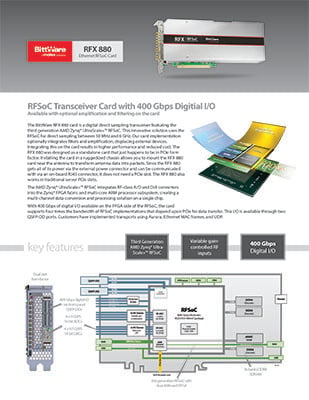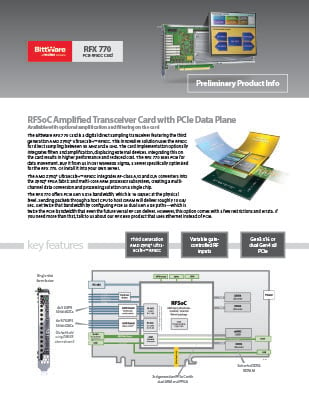RFX 880 + 770
Direct RF Cards Featuring the AMD RFSoC
Analog: 4x 5 GSPS 14-bit ADCs + 4x 9.7 GSPS 14-bit DACs
Digital: Up to 400 Gb/s I/O (RFX 880) or PCIe Gen4 x8x8 (RFX 770)

Integrated Amplification and Filtering
With RFX, You've got Options
At the heart of RFX products is the revolutionary AMD RFSoC chip, giving you a range of advantages over discreet systems. However, BittWare has leveraged our analog and digital design heritage to bring you more than expected from a typical RF card:
- Direct sampling between 50 MHz and 6 GHz
- Built-in amplifier/filter options to target first, second, or third Nyquist
- Wideband options to bypass the filtering/amplifiers
- Up to 400 Gb/s digital I/O with options for PCIe- or QSFP-focused architectures
- Modular build options for our WaveBox RF servers
- Standalone (with QSFP I/O) or as PCIe card
Powered by 3rd Gen AMD Zynq UltraScale+ RFSoC
RFX cards and modules are built around the powerful AMD RFSoC devices. We bring analog signals in, but it’s the direct RF chip approach that packs so much analog and digital functionality that many racks of previous equipment are no longer necessary!
- Lower power by eliminating JESD204 interfaces
- Smaller physical space
- Programmable (FPGA) logic for diverse requirements and emerging standards
- Built-in ARM processing lets you do more in a standalone deployment
Designed for WaveBox
The RFX family is designed as standalone cards or as modules in servers. We recommend the WaveBox family of enclosures and servers for the optimum mix of features and the advantage of purchasing an integrated system. Learn more on the WaveBox product page.
Where RFX Fits
At the heart of RFX cards and modules is the AMD RFSoC chip. It combines many of the traditionally discreet RF analog and digital components into a compact, configurable device. Applications including Satcom and test/measurement can benefit from these revolutionary devices.
But with RFX we’ve gone further—bringing to the PCIe form factor optional mixers, amplifiers, and filters. The RFX is configurable too, with up to four inputs/outputs and first/second/third Nyquist filters.
Analog Mixing, Amplification, and Filtering Options
On-Card ADCs and DACs
Choose from on-card filtering and amplification targeting first, second, or third (partial) Nyquist. Or choose “wideband” and bring your own external filtering. Here’s the input ADC:
There are four of these ADC channels, each factory configurable (talk to us for pricing and availability).
Four DACs provide 30 to 6 GHz with low-pass filtering. This transmit side diagram is below:
Utility Software Included with RFX and WaveBox products
In development, configuring advanced RF devices using scripts can be problematic. That’s why we developed RFX Surfer, and best of all it’s free with many of our direct RF cards and enclosures (including source code)!
Watch our demo video to get the basics of what this GUI can do!
Transcript (click to show/hide)
Welcome to this demo of RFX Surfer, a graphical user interface designed to simplify the configuration, monitoring, and analysis of RFX and WaveBox products over Ethernet. RFX Surfer acts as a versatile client that can connect to many BittWare RF products including the RFX 880, 770, and WaveBox, providing users with detailed control, tone generation, and real-time visualization.
Connecting to Your RFX Card
Getting started with RFX Surfer is straightforward. Simply provide the IP address of your RFX product and hit connect. Once connected, the software retrieves key information stored on the card, including serial number, software version, firmware version, build time, acquisition type, and VCXO frequency. This data is displayed clearly on the host PC, offering immediate insight into the card’s identity and status.
Hardware Monitoring and Diagnostics
Within the hardware monitor tab, users can view vital system information such as temperatures from multiple sensors distributed across the card, and see alerts triggered by the card’s monitoring circuitry. This tab also provides access to the boot log — a valuable resource for diagnosing issues during development or characterization phases.
Configurable Card Settings
The settings tab presents a rich set of configurable parameters that adapt to the specific options of the connected card. These include clock source selection, PLL configurations, and specialized RF ADC and DAC settings associated with the AMD RF Data Converter IP.
RFX Surfer’s GUI intelligently adapts according to the connected card model, enabling or disabling options as appropriate to prevent configuration errors. This smart behavior ensures users can only select valid settings, helping prevent mistakes during setup.
Waveform Generation and Visualization
The waveform tab focuses on the DAC outputs of the RFX card. Here, users can specify tones for up to four DAC channels independently. The interface provides graphical visualization of these tones in both the frequency and time domains, making it easy to understand the output signal characteristics.
Users can select single or dual-tone modes, adjust frequencies and amplitudes, and observe the expected output of waveform. For example, setting a tone to 1.2 GHz reflects in the visualization. When the DAC output is connected to external test equipment such as a spectrum analyzer, you’d see a similar output. Of course, for demonstrations we can use loopback cables from one or more DAC channels to the analog inputs—the ADCs—and use the RFX Surfer Plot tab to see a real-time analysis of the signals from the loopback. In fact, let’s now switch to that now.
Real-Time ADC Capture and FFT Analysis
So now on the Plot tab, RFX Surfer enables real-time capture of snapshot data packets from the card’s ADCs. As data streams in, the tool performs Fast Fourier Transform (FFT) analysis on each packet, presenting live views in both time and frequency domains.
Users control which ADC channels to enable, start and stop streaming, and monitor detailed logs showing card configuration updates. These visualizations can be saved as images for reporting or troubleshooting purposes.
We also support saving a snapshot to a binary file, which you can then open in BinView. This tool allows you to look in more detail, see the raw data, or do further post-processing.
Integrated Signal Generator Control
RFX Surfer also includes the ability to control external signal generators via IP, sending commands to adjust frequency and amplitude remotely. Users can manually set frequencies, sweep across ranges with defined start and stop points, step sizes, power levels, and automatically log FFT measurements at each step.
This integrated functionality streamlines characterization workflows by synchronizing signal generation with data capture and analysis within a single interface.
Dual-Tone and Intermodulation Measurements
For advanced testing, dual-tone configurations are supported on respective DAC and ADC channels. Enabling the intermodulation measurement option allows the software to lock onto multiple tones and display detailed detected tone information from the ADC side.
Cross-Platform Support
RFX Surfer runs natively on Windows and Linux, providing flexibility for a range of development and production environments. This cross-platform compatibility ensures users can deploy the tool wherever needed without compromise.
Documentation and Source Code Availability
Comprehensive user documentation accompanies RFX Surfer, covering all GUI widgets, underlying architecture, communication protocols, and troubleshooting guidance. This helps new users quickly understand the tool’s capabilities and allows experienced users to explore advanced features confidently.
Additionally, the source code for RFX Surfer is included with RFX purchases for you to customize.
Summary and Benefits
In summary, RFX Surfer is a smart, user-friendly interface that automates many of the complex tasks associated with configuring, monitoring, and analyzing RFX cards. It eliminates common configuration errors through its adaptive GUI, accelerates characterization with integrated signal generation and data analysis, and supports Linux and Windows platforms.
Thank you for watching this demo of RFX Surfer. For more information, visit us at BittWare.com.
Specifications + Data Sheet
RFX 880
RFX 770
RFSoC
- AMD Zynq UltraScale+ RFSoC
- XCZU43 in a G1517 package
- Core speed grade -2
Processing Subsystem (PS)
- Application Processing Unit Quad-core Arm Cortex-A53 MPCore at 1.2 GHz
- Real-Time Processing Unit Dual-core Arm Cortex-R5F MPCore at 525 MHz
Analog
- 4x 5 GSPS 14-bit ADCs
- Wideband build option provides +0 to -27 dB gain from 50 MHz to 6 GHz (or 7.5 GHz) with no filtration
- 1st Nyquist (L-Band) build option provides +41 to -29 dB on all 4 channels, constrained between 400 MHz and 2.5 GHz by filters FL1 and FL2
- 2nd and 3rd Nyquist filters are also available on amplified channels as a special order
- Max input power -22 dBm on the amplified version and +15 dBm on the wideband
- 4x 9.7 GSPS 14-bit DACs
- Range of +3 to -24 dBm (high power end of this range is a function of frequency)
- Constrained by a 4.8 GHz LPF
- Balun used in both ADC and DAC channels begins its frequency roll-off at 6 GHz
- Programmable clocks
- External reference and triggers
- Push-on SMPM connectors with optional SMA pigtails
External digital interface
- Up to 400 Gb/s available via front panel 2x QSFP-DD
- AMD Hard IP support for dual 100GbE
RFSoC
- AMD Zynq UltraScale+ RFSoC
- ZU43DR in a G1517package
- Core speed grade -2
Processing Subsystem (PS)
- Application Processing Unit Quad-core Arm Cortex-A53 MPCore at 1.2 GHz
- Real-Time Processing Unit Dual-core Arm Cortex-R5F MPCore at 525 MHz
Analog
- 4x 5 GSPS 14-bit ADCs
- Wideband build option provides +0 to -27 dB gain from 50 MHz to 6 GHz (or 7.5 GHz) with no filtration
- 1st Nyquist (L-Band) build option provides +41 to -29 dB on all 4 channels, constrained between 400 MHz and 2.5 GHz by filters FL1 and FL2
- 2nd and 3rd Nyquist filters are also available on amplified channels as a special order
- Max input power -22 dBm on the amplified version and +15 dBm on the wideband
- 4x 9.7 GSPS 14-bit DACs
- Range of +3 to -24 dBm (high power end of this range is a function of frequency)
- Constrained by a 4.8 GHz LPF (FL3)
- Balun used in both ADC and DAC channels begins its frequency roll-off at 6 GHz
- Programmable clocks
- External reference and triggers
- Push-on SMPM connectors with optional SMA pigtails
Host interface
- x16 Gen3 or bifurcated dual x8 Gen4 interfaces direct to PL
(dual PCIe Gen 4 x8 with restrictions and errata)
Want More Details?
Request the RFX 880 Hardware Reference Guide (HRG)
The HRG gives you much more detail about the card such as block diagrams, tables and descriptions.
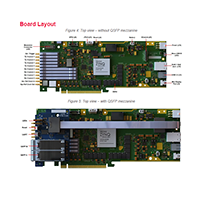
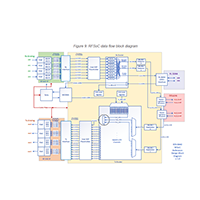
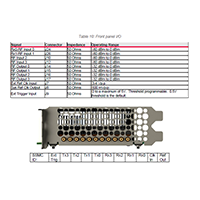
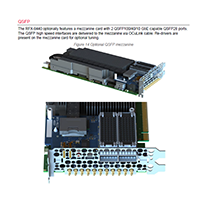
Interested in Pricing or More Information?
Our technical sales team is ready to provide availability and configuration information, or answer your technical questions.
"*" indicates required fields
